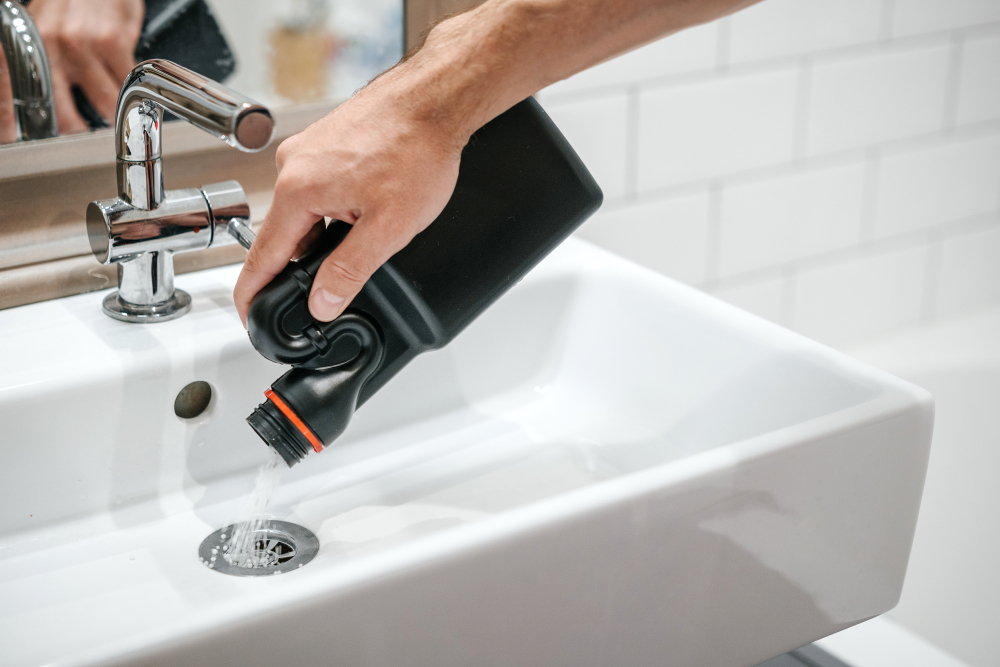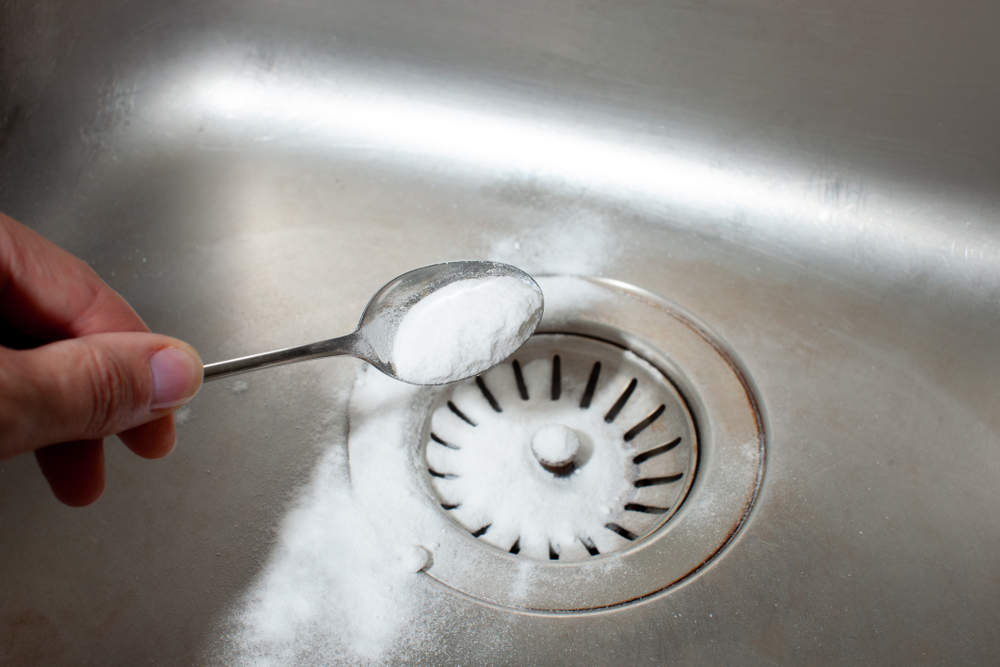Understanding the Science Behind Chemical Drain Cleaners
Chemical drain cleaners are the unsung heroes of household maintenance, silently working to alleviate the frustration caused by clogged drains. In this in-depth exploration, we’ll dissect the intricate workings of these potent solutions, unraveling the mysteries of their chemical compositions and elucidating their mechanisms of action. From caustic to acidic formulations, we’ll delve into the science behind these cleaners, exploring their ingredients, applications, advantages, disadvantages, and safety considerations.

How do chemical drain cleaners work?
At the heart of chemical drain cleaners lies a fundamental understanding of chemistry, where reactive substances are harnessed to tackle stubborn clogs. These cleaners operate through a combination of chemical reactions aimed at breaking down and dissolving the materials obstructing drains.
- Caustic Drain Cleaners: Caustic drain cleaners wield the power of alkaline substances, most commonly sodium hydroxide (NaOH), also known as lye or caustic soda. When introduced to a clogged drain, sodium hydroxide initiates a process known as saponification. This chemical reaction converts fats, oils, and grease into water-soluble soap molecules. The soap effectively emulsifies the organic matter, allowing it to be easily rinsed away with water, thereby clearing the obstruction and restoring the flow of drainage.
- Acidic Drain Cleaners: Contrasting with their caustic counterparts, acidic drain cleaners utilize the corrosive properties of acids to dissolve mineral deposits and organic materials. Sulfuric acid (H2SO4) and hydrochloric acid (HCl) are among the most common acids employed in acidic drain cleaners. Upon contact with the clog, these acids react with the substances comprising the blockage, breaking them down into smaller, soluble components. As the obstruction disintegrates, it becomes easier to flush away, allowing for the restoration of unimpeded drainage.
- Ingredients in Chemical Drain Cleaners: The efficacy of chemical drain cleaners hinges upon the precise combination of ingredients engineered to combat clogs effectively. These cleaners typically contain a blend of active agents, surfactants, corrosion inhibitors, and other additives, each playing a crucial role in the cleaning process.
- Sodium Hydroxide (NaOH): As a potent alkaline compound, sodium hydroxide serves as the primary active ingredient in many caustic drain cleaners. Its ability to saponify fats and oils makes it a formidable adversary against greasy clogs.
Sulfuric Acid (H2SO4) and Hydrochloric Acid (HCl): These strong acids are the key components of acidic drain cleaners, capable of dissolving mineral deposits, organic matter, and other stubborn obstructions. - Surfactants: Surface-active agents, or surfactants, are incorporated into drain cleaners to aid in the dispersion and emulsification of debris. By reducing surface tension, surfactants help ensure thorough contact between the cleaner and the clog, enhancing the cleaning process.
- Corrosion Inhibitors: Given the corrosive nature of certain ingredients, corrosion inhibitors are often included in drain cleaners to protect metal pipes from degradation. These additives form a protective barrier on the surface of the pipes, mitigating the risk of damage.
The Process of Unclogging a Drain with Chemical Cleaners
- Preparation: Before embarking on the unclogging process, it’s essential to prepare the area and gather the necessary supplies. This includes ensuring adequate ventilation to disperse fumes and donning appropriate protective gear such as gloves and eye protection.
- Application: Carefully read and follow the instructions provided on the product label to determine the appropriate amount of cleaner to use. Slowly pour the cleaner directly into the clogged drain, taking care to avoid splashes or spills.
- Reaction: Allow the cleaner to work its magic, allowing sufficient time for the chemical reactions to occur. The duration may vary depending on the severity of the clog and the specific formulation of the cleaner. During this period, the active ingredients penetrate the obstruction, breaking it down into smaller, soluble components.
- Flushing: After the designated waiting period, flush the drain with hot water to remove any residual debris and leftover cleaner. This final step helps ensure that the drain is thoroughly cleared, restoring optimal flow and functionality.

Advantages and Disadvantages of Using Chemical Drain Cleaners
Advantages:
- Convenience: Chemical drain cleaners offer a convenient and accessible solution to common plumbing issues, eliminating the need for professional intervention in many cases. With these readily available products, homeowners can address clogs swiftly and effectively without the hassle of scheduling appointments or waiting for assistance.
- Effectiveness: When used as directed, chemical drain cleaners can deliver impressive results, dissolving tough clogs and restoring proper drainage. Their powerful formulations are capable of penetrating and disintegrating various types of obstructions, from grease and hair to mineral deposits and organic matter.
Disadvantages:
- Potential Damage to Pipes: One of the primary concerns associated with chemical drain cleaners is the potential for damage to plumbing pipes. The corrosive nature of certain ingredients, particularly acids, can pose a risk to pipes, especially if they are old, corroded, or made of vulnerable materials such as PVC. Prolonged exposure to these harsh chemicals may accelerate pipe corrosion, leading to pipe leaks, fractures, or other structural issues.
- Environmental Impact: The disposal of chemical drain cleaners presents environmental considerations, as the residual chemicals can pose a threat to ecosystems if improperly handled. The release of these substances into waterways can contaminate aquatic habitats and harm marine life, disrupting fragile ecosystems and biodiversity. Additionally, the manufacturing and distribution processes of these products contribute to environmental pollution, further exacerbating their ecological footprint.
Alternative Methods for Unclogging Drains
While chemical drain cleaners offer a convenient solution to clogged drains, they are not the only option available. Homeowners can explore alternative methods that are less abrasive to pipes and more environmentally friendly:
- Plunging: A plunger is a simple yet effective tool for dislodging minor clogs in sinks, toilets, and tubs. By creating a tight seal around the drain opening and exerting pressure through pumping motions, plunging can often dislodge obstructions and restore proper drainage without the need for chemical intervention.
- Mechanical Snaking: For more stubborn clogs that resist plunging or chemical treatments, a drain snake, also known as an auger, offers a mechanical solution. This flexible tool is designed to navigate through pipes, breaking apart or retrieving debris obstructing the flow of water. By physically clearing the obstruction, drain snakes provide a targeted and non-destructive method of unclogging drains.
- Natural Remedies: Some homeowners prefer to adopt a gentler approach to drain cleaning by utilizing natural ingredients and homemade remedies. Baking soda, vinegar, and enzymatic cleaners are among the natural substances commonly employed to tackle clogs without resorting to harsh chemicals. These alternatives offer a more eco-friendly solution that is gentle on pipes and safe for the environment.

Safety Tips for Using Chemical Drain Cleaners
While chemical drain cleaners can be effective tools for unclogging drains, it’s essential to prioritize safety when handling these potent substances. Here are some key safety tips to keep in mind:
- Read and Follow Instructions: Before using chemical drain cleaners, carefully read and adhere to the instructions provided on the product label. Pay close attention to dosage recommendations, application procedures, and safety precautions to ensure optimal results and minimize risks.
- Protective Gear: When handling chemical drain cleaners, wear appropriate protective gear to shield yourself from potential contact with the cleaner and its fumes. This includes gloves to protect your skin from irritation or chemical burns and goggles to safeguard your eyes from splashes or aerosolized droplets.
- Ventilation: Work in a well-ventilated area to minimize exposure to chemical vapors and promote airflow. Open windows and doors to facilitate the dispersal of fumes and ensure adequate ventilation throughout the cleaning process. If possible, use fans or ventilation systems to further enhance air circulation and reduce the concentration of airborne contaminants.
- Avoid Mixing Cleaners: Never mix different types of drain cleaners, as this can result in hazardous chemical reactions and release toxic gases. Mixing incompatible chemicals can produce heat, pressure, or noxious fumes, posing a serious risk of injury or property damage. Stick to one type of cleaner at a time and avoid combining products with different active ingredients.
- Proper Disposal: Dispose of leftover cleaner and empty containers according to local regulations and guidelines. Avoid pouring unused cleaner down the drain or into storm drains, as this can contribute to environmental pollution and contaminate waterways. Instead, seal the container tightly and dispose of it in accordance with municipal waste disposal protocols.
Conclusion
Chemical drain cleaners represent a potent solution to the common nuisance of clogged drains, harnessing the power of chemistry to dissolve obstructions and restore proper drainage. By understanding the mechanisms of these cleaners and considering their advantages and disadvantages, homeowners can make informed decisions about their use and ensure safe and effective results. However, it’s essential to exercise caution and prioritize safety when handling chemical cleaners, as they can pose risks to both individuals and the environment if mishandled or misused. By following proper safety protocols, exploring alternative methods, and adopting eco-friendly practices, homeowners can maintain the functionality of their plumbing systems while minimizing potential harm. Ultimately, responsible usage of chemical drain cleaners entails a balance of efficacy, safety, and environmental stewardship, ensuring both clean drains and a cleaner planet for future generations.
Plumbing Services CA
https://maps.app.goo.gl/31Yt4rhDrainzNJ4A
(279) 203-0765
https://plumbingservicesca.com/
